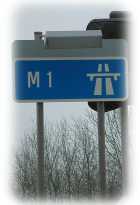Motorway driving - General Information
 Although motorways make up only a small percentage of the UK road network, they carry over a third of all heavy freight traffic. Despite this high volume of traffic, motorways should still be the safest roads to drive on.
Although motorways make up only a small percentage of the UK road network, they carry over a third of all heavy freight traffic. Despite this high volume of traffic, motorways should still be the safest roads to drive on.
The greater safety is because motorways have none of the common hazards that are found on other roads. On motorways, there are no traffic lights, T-junctions, cross roads, etc.
Many of the problems, associated with motorway driving, could probably be overcome if more people took practical motorway training.
This page offers a quick overview of motorway basics to consolidate your knowledge of the rules, regulations and techniques required for safe motorway driving. You can find more detailed information about motorways in the Drivers Area – Motorway Driving.
You should aim to get at least one hour's practise on a motorways with lots of entering and leaving before taking Part-Two paying particular attention to the following points.
Watch the videos below for more info about motorways generally and ADI Part-Two
Reading the road
Because of higher speeds you need to monitor the road well ahead. This means watching for brake lights half-a-mile or more ahead when travelling at speed. On motorway journeys you can often travel for miles with the same drivers for 'company'. By noticing the driving habits of those around you you can avoid nasty surprises.
During a normal motorway journey, you should never need to use your brakes. Forward observation and good acceleration sense should provide all the control you need.
Use of signals
Remember that the purpose of signals is to help or warn others? You wouldn't think so judging by the signal use of a lot of drivers on our motorways!
Many drivers signal late on motorways – they start to manoeuvre before the signal comes on.
Your routine should be:
- Mirror; Signal; Mirror (check for reaction to your signal); Manoeuvre -
- Allow your signals to flash at least four times before you start to move - preferably six times.
This gives plenty of warning to others.
Road position
Good lane discipline is essential for safety on the motorway. You can take this one step further by controlled use of lane three.
Never put yourself in a position where there are two lorries (or a car/van and lorry) side by side to your left. In an emergency you would be left without an 'escape route'.
Plan your driving so that when you are in lane three you always have a gap to your left. In other words, never start an overtake that you cannot complete. Also remember that if you cannot see a truck driver in his mirrors, he will find it difficult to see you.
The only exception to these positioning rules would be in slow traffic travelling at less than 30mph, but even then, use extreme caution.
Following distance
Motorway bridges or overhead gantry signs provide excellent markers for measuring your two-second rule gap (remember to at least double this distance in the wet).
Practice maintaining this distance until it becomes habit.
Overtaking
By following all of the 'rules' outlined above you should overtake safely.
Remember that you are preparing to be tested at an advanced standard. This means that you must take safe opportunities to overtake when they arise. If you are a driver who normally drives at a steady 50mph on motorway journeys, put your foot down!
Worksheet
Download the project worksheet to rate your motorway driving. Here